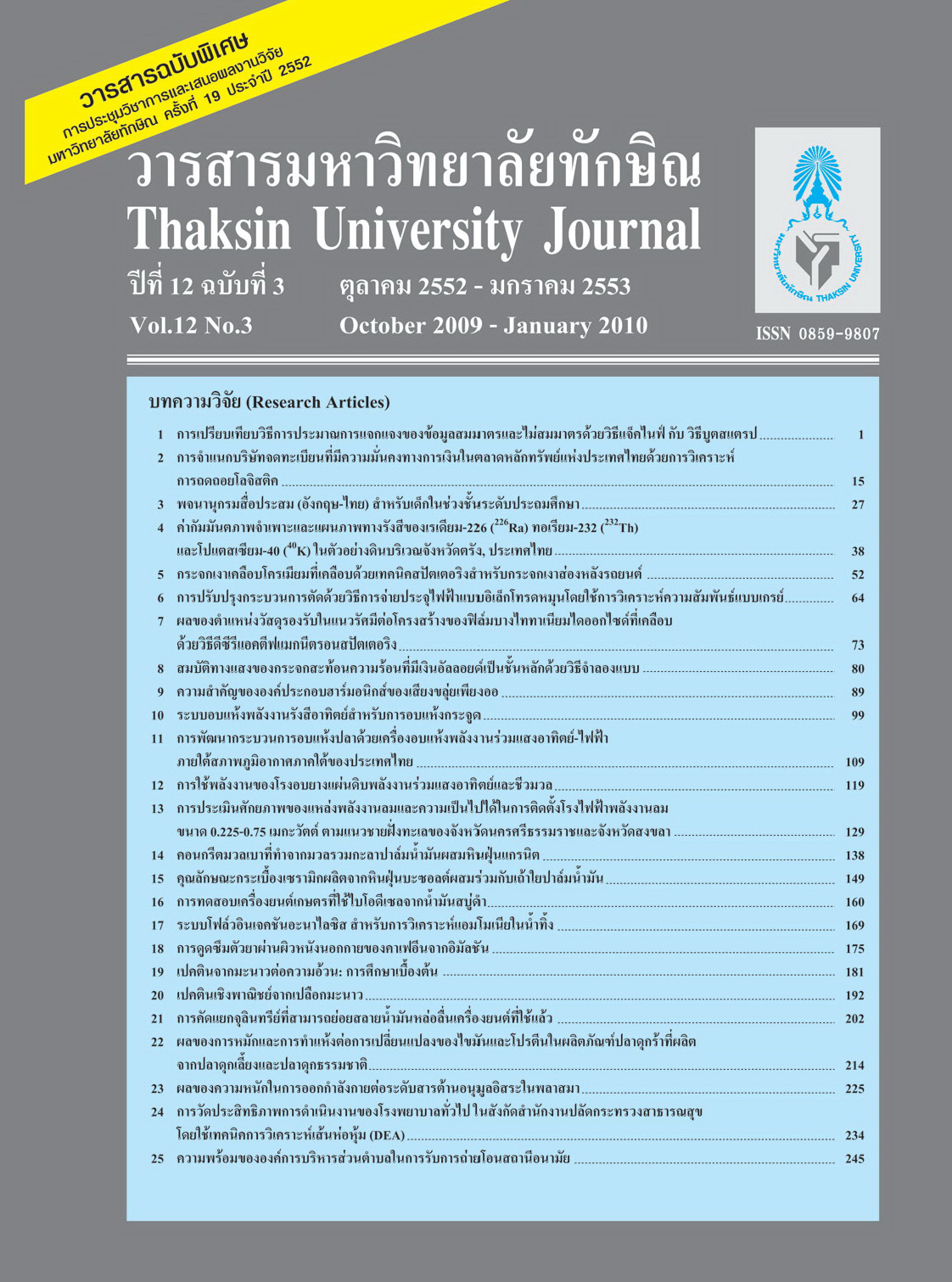ผลของการหมักและการทำแห้งต่อการเปลี่ยนแปลงของไขมันและโปรตีนในผลิตภัณฑ์ปลาดุกร้า ที่ผลิตจากปลาดุกเลี้ยงและปลาดุกธรรมชาติ
Main Article Content
Abstract
การศึกษาองค์ประกอบทางเคมีทั้งในส่วนเนื้อและส่วนหนังของปลาดุกสดและปลาดุกร้าที่ผลิตจากปลาดุกเลี้ยง และปลาดุกธรรมชาติ พบว่าปลาดุกร้ามีโปรตีน ไขมัน เถ้า สูงกว่าปลาดุกสด แต่อย่างไรก็ตามปลาดุกเลี้ยงมีไขมันสูงกว่า ปลาดุกธรรมชาติทั้งในปลาดุกสดและปลาดุกร้า (P≤0.05) เมื่อผ่านกระบวนการหมักและการทำแห้งพบว่าปลาดุกทั้งสอง ชนิดมีปริมาณกรดไขมันอิสระเพิ่มขึ้น ส่วนไตรกลีเซอไรด์และฟอสฟอลิพิดมีปริมาณลดลง ในขณะเดียวกันกรดไขมัน ชนิดไม่อิ่มตัวชนิด EPA และ DHA ก็ลดลงอย่างมีนัยสำคัญทางสถิติ (P≤0.05) จากการทดลองนี้แสดงให้เห็นว่าการหมัก และการทำแห้งส่งผลให้เกิดปฏิกิริยาออกซิเดชัน และไฮโดรลิซิสของไขมัน เมื่อศึกษาการแยกส่วนโปรตีนในกล้ามเนื้อ ของปลาดุกทั้งสองชนิด พบว่าโปรตีนไมโอไพบริลเป็นโปรตีนหลักของกล้ามเนื้อปลาดุก ซึ่งมีปริมาณร้อยละ 50.44-55.04 ตามด้วยโปรตีนชาร์โคพลาสมิกร้อยละ 29.29–29.30 โปรตีนละลายได้ในน้ำร้อยละ 13.64-16.17 และโปรตีนสโตรมา ร้อยละ 2.07-3.49 ตามลำดับ จากการศึกษารูปแบบของโปรตีนโดยใช้ SDS- PAGE พบว่ากล้ามเนื้อปลาดุกมีโปรตีน ไมโอซินโมเลกุลหนัก (MHC) และโปรตีนแอคตินเป็นองค์ประกอบหลัก แต่หลังจากการแปรรูปโปรตีนทั้งสองชนิดถูก ย่อยสลาย ทำให้มีปริมาณลดลง
The chemical compositions of wild and farmed catfish in skin and muscle portions were analyzed. Pla-duk-ra had higher lipid, protein and ash contents than raw catfish. However, the farmed catfish had higher lipid content than wild catfish. Both catfish showed marked increases in free fatty acids, with decreases in triglyceride and phospholipid content after drying and fermentation (P≤0.05). This suggested that hydrolysis was induced by lipases and phospholipases. Decreases in polyunsaturated fatty acids, especially eicosapentaenoic acid (EPA) and lipases and phospholipases. Decreases in polyunsaturated fatty acids, especially eicosapentaenoic acid (EPA) and docosahexaenoic acid (DHA), were observed. Drying and fermentation caused the changes of chemical composition, lipolysis and lipid oxidation of catfish muscle and skin portions. Both catfish muscle had myofibrillar proteins as the major protein (50.44-55.04%) followed by sarcoplasmic protein (29.23-29.90%), alkali soluble protein (13.64-16.17%) and stroma protein (2.07-3.49%). Sodium dodecylsulfate-polyacrylamide gel electrophoresis (SDS-PAGE) analysis revealed that myosin heavy chain (MHC) and actin were the major proteins in both species. After drying and fermentation of pla-duk-ra , MHC and actin were decreased. These data indicated that the myofibrila proteins of both catfish were hydrolyzed during processing.


